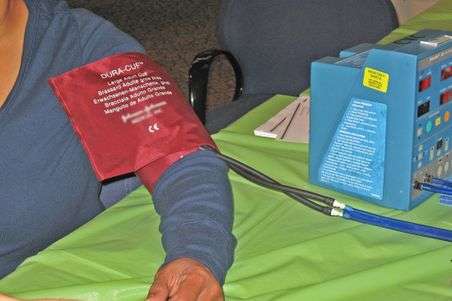Lower blood pressure targets safe in reducing risk of recurrent stroke

Stroke patients who lowered their systolic blood pressure below 130 mm Hg were significantly less likely to have a recurrent stroke caused by a brain bleed compared with those who didn't lower their pressure that far, according to late-breaking science presented at the American Stroke Association's International Stroke Conference 2013.
The findings may provide physicians with more definitive treatment targets for patients with a history of subcortical or lacunar stroke. Subcortical stroke accounts for 25 percent of all ischemic strokes and occurs when small, intricate arteries deep within the brain are affected.
Normal systolic blood pressure is less than 120 millimeters of mercury (mm Hg). Systolic pressure is the top number in a blood pressure reading and represents the pressure in the arteries when the heart beats. Pre-hypertension is systolic pressure between 120 mm Hg and 139 mm Hg. People with pre-hypertension are likely to develop high blood pressure unless steps are taken to control it. Hypertension or high blood pressure is systolic pressure above 140 mm Hg.
"We know keeping blood pressure low protects against a first and a recurrent stroke," said study author Oscar Benavente, M.D., professor and research director of stroke at the University of British Columbia in Vancouver, British Columbia, Canada. "But we don't know how low it needs to go, and our study provided some answers."
In the Secondary Prevention of Small Subcortical Strokes (SPS3) Trial, Benavente and colleagues divided 3,020 patients into two target groups of blood pressure control. Outcomes were compared between those assigned to the "lower target" systolic blood pressure below 130 mm Hg and those treated to achieve a "higher target" between130 mm Hg and 149 mm Hg.
The study enrolled patients from North America, South America and Europe from 2003 to 2011. All had previously suffered a small subcortical stroke. At the start of the study, the two treatment groups had similar systolic blood pressure. Patients' were age 63 on average, 63 percent were men, 75 percent had a history of high blood pressure, 37 percent had a history of diabetes and 20 percent were current tobacco users.
Among their findings:
- After one year of treatment, the group assigned to achieve a lower blood pressure had an average systolic blood pressure of 126.8 mm Hg while the other group averaged 137.8 mm Hg. The average follow-up lasted about 3.7 years.
- Bleeding in the brain, also known as intracerebral hemorrhage, was reduced by 63 percent in those who achieved blood pressure levels below 130 mm Hg of systolic pressure as compared with those who lowered their blood pressure levels between 130 mm Hg and 149 mm Hg.
- Stroke recurrence in either group was lower among those who had greater reductions in their blood pressure levels (2.25 percent per year) compared with those who did not lower their blood pressure as much (2.77 percent per year). The difference is not statistically significant.
Benavente noted that the study was not designed to analyze differences in the blood pressure-lowering medicines patients took. Instead it focused on whether one blood pressure benchmark was better than another. However, patients assigned to the lower target took more medications and the distribution of medications by groups were not the same.
"What the study tells us is that a systolic reading of 135 mm Hg may not be enough, but that getting the blood pressure down to below 130 mm Hg may offer our stroke patients greater clinical benefits," Benavente said. "I would tell my patients who had this type of stroke to get their blood pressure below 130."















